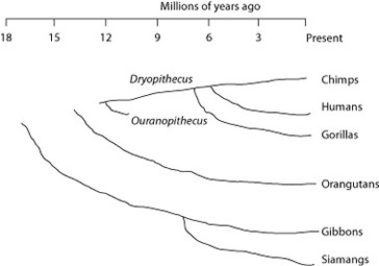Use the following figure and description to answer the question.
Humans, chimpanzees, gorillas, and orangutans are members of a clade called the great apes, which shared a common ancestor about 15 million years ago. Gibbons and siamangs comprise a clade called the lesser apes. Tree-branch lengths indicate elapsed time.
Assuming chimps and gorillas are humans' closest relatives, removing humans from the great ape clade and placing them in a different clade has the effect of making the phylogenetic tree of the great apes ________.
Definitions:
Bronchi
The major air passages of the lungs that diverge from the windpipe, providing a pathway for air to reach the lungs.
Carbon Dioxide
It's a transparent, unscented gas formed through the burning of carbon-containing compounds and the act of breathing, which is assimilated by plants in the photosynthesis process.
Bicarbonate Ions
Bicarbonate ions (HCO3-) act as a buffer in biological systems, helping to maintain pH balance in blood and other bodily fluids.
Carbonic Anhydrase
An enzyme that catalyzes the conversion of carbon dioxide and water into carbonic acid, playing a vital role in respiratory gas exchange and pH balance.
Q2: If you were using cladistics to build
Q6: After the drought of 1977, researchers hypothesized
Q10: What can proteomics reveal that genomics cannot?<br>A)
Q18: In some jacana species, males take care
Q21: RNAi methodology uses double-stranded pieces of RNA
Q30: Use the following information to answer the
Q35: Which of these conditions are always true
Q36: Use the following information to answer the
Q38: <img src="https://d2lvgg3v3hfg70.cloudfront.net/TB3075/.jpg" alt=" A phylogenetic tree
Q51: Cotton-topped tamarins are small primates with tufts